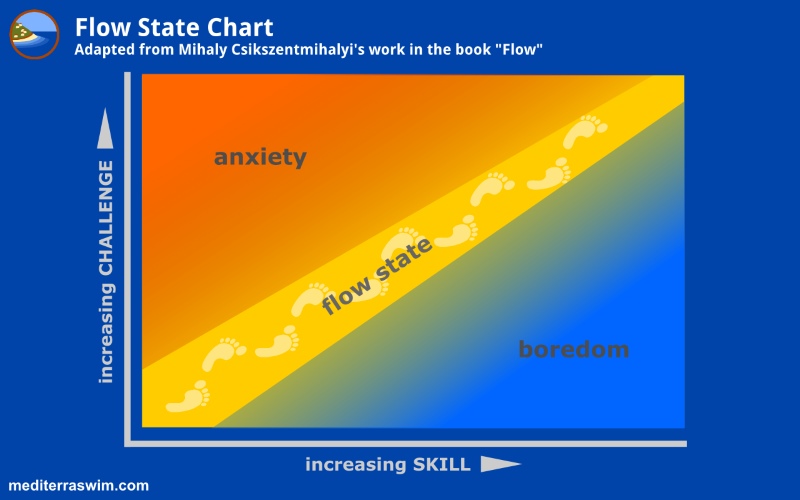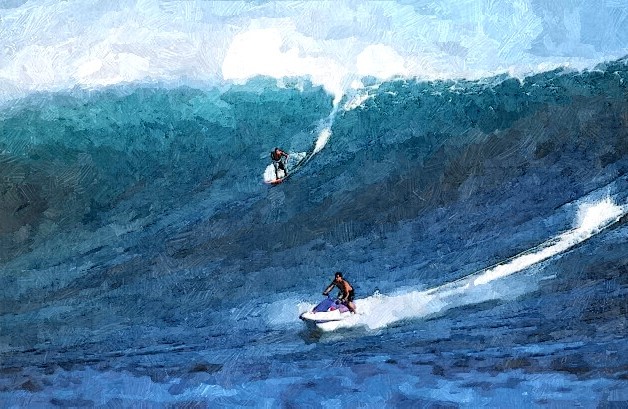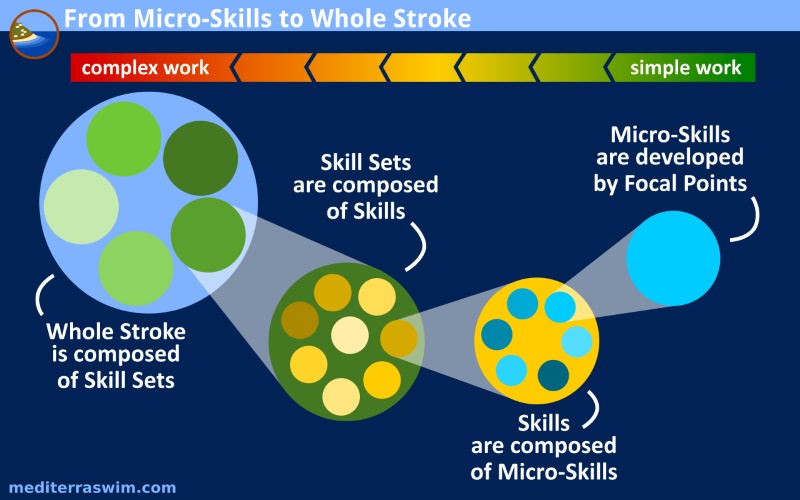by Admin Mediterra | Sep 28, 2020 | Skill Learning
Once you find a certain skill challenge becoming relatively easy to control under the easy drill or whole stroke conditions you are working in, you turn up the challenge of the conditions a notch to expand or to further deepen your skill and fitness together.
The most simple changes you can make is with cues:
- Choose new cues
- Blend two or three cues togeter (e.g. from holding A to holding AB, from AB to ABC)
In combination with cues, you can adjust challenge level further by (roughly in ascending order of difficulty):
- Add stroke counting (simply counting).
- Add SPL control (holding SPL steady).
- Lengthen the stroke (lower SPL by -1).
- Add comfortable Tempo (using the beep of a Tempo Trainer – simply keeping time).
- Change the point in the stroke at which the Tempo beep is synchronized to.
- Add slower-than-comfortable Tempo.
- Add faster-than-comfortable Tempo.
- Add more distance by adding more repetitions or rounds (which means holding attention more often).
- Add more distance by making each repetition or interval longer (which means holding attention for longer spans of time).
- Add SPL control and comfortable Tempo control at the same time.
- Add SPL control and slower-than-normal Tempo control at the same time.
- Add SPL control and faster-than-normal Tempo control at the same time.
- Convert passive Rest Intervals into active Rest Intervals (rather than sit at the wall, do a drill or swim gently).
- Make shorter or remove Rest Intervals.
No matter the current level of neuro-muscular skill and fitness you feel you have, you can take any practice set and modify it in small but powerful ways to take you into a new level of skill and fitness.
by Admin Mediterra | Sep 28, 2020 | Skill Learning
In our practices we are trying to achieve two things: improvement in our capabilities, and improvement in our enjoyment of practice and performance.
One concept captures both…
Enter into Flow State

This is when both skill and satisfaction in the act of practice (or in the performance) are in their peak growth state.
Too much challenge that is far beyond your current skill and you get anxiety or frustration, and perhaps injury. Too little challenge and you get bored, the mind wanders and skill-growth diminishes.
The practical application for this is to design practices that provide just enough challenge that is not too much nor too little. This is as much of an art as it is a science. And it is profoundly personal.
So, what virtually everything in our coaching service is aimed at is to guide you into the understand and skills you need to keep yourself in Flow State while practicing (and racing, if you do that) – and, hopefully to carry that over into other areas of your life too!
Personalizing The Variables Of Practice
In order to design practices that provide the optimal amount of challenge for you, you need to choose the distances, the number of repeats, the intensity level, the cues, and the feedback metrics to put yourself in that zone. Following the guidelines of our approach you will come to know the science part (principles of physics and physiology), while also working on the is the art part to make it fit you as a unique individual (personalization).
Here are the nuts and bolts:
We can customize the challenge level of the practice set for any swimmer at any skill or fitness level – we do it by increasing the neuro-muscular complexity of the task.
Remember, the brain’s main function (according to some neuro-scientists) is ‘to manage information and energy’. The brain controls the production of energy, and it controls the firing of muscles, which use the energy. Information allows the brain to make decisions about where and how energy should be used, which muscles should be activated. Fitness is the body’s ability to convert fuel to create power. Technique is the brain’s ability to skillfully apply that that power where, when and how it is needed to get the job done well.
So, to provide complete training we must challenge the brain while we challenge the body.
You can Increase Complexity by Using Challenge Modifiers.
In this way, the steps of our approach to advanced training can be followed by any swimmer at any performance level. The same skill might be strong at this level, but once you increase the complexity you find you can strengthen it more. Each skill you’ve worked on once can be revisited to create greater skill-resilience at higher speed, over longer distance. And, even the foundational skills can be improved and refined to finer and finer level of detail that you only notice once you turn up the complexity of the problems you try to solve.
This is a primary reason why we don’t write simple practices as if one size fits everyone. We can give you some ideas to start with, but then we expect you to start adjusting those to facilitate your own Flow State – something we cannot ultimately do for you, only guide you in how to find.
Like jet-ski taxis for the surfers of the giant waves, we can tow you up to the edge of that Flow State zone, but you’ve got to ride into it and keep yourself there.

Ride on into flow!
by Admin Mediterra | Sep 24, 2020 | Practice Design
Our training courses have provided structure and a general practice pattern for you, choosing the skills, the drills and the cues. But, there may be some decisions you should make in order to make each practice fit you even better…
These are the basic decisions you make when either designing or modifying a practice plan to fit you better:
Decision #1 – Choose Skill Projects
In each week of the training plan there are certain skill projects assigned, so you don’t need to change this unless you have a reason to.
In most of our training plans you will work on the same skill projects for the entire week, and work on them in different modes according to the practice type. In each practice of the week, you may decide which of those assignments you will work on today. You may work on more than one.
Decision #2 – Choose Appropriate Drills
There may be a combination of drill and whole stroke activities assigned. You will need to choose which drill fits the skill project. The drill activities you choose should match the complexity level you feel you need to work at in this skill. See Choosing Your Activities and Complexity for a description of those levels.
You may select a drill from those you learned in your live training experience, or you may take one from the Perpetual Motion Freestyle (PMF) video series, or from the Ultra-Efficient Freestyle (UEF) video series.
Decision #3 – Choose Cues
For each skill project there are a menu of cues you have learned already in your live training experience, which are also listed on the lesson notes. You may review the standard cues on the lesson notes or use some from our 101 Cues for Freestyle page, or one from your live training notes. Cues (aka ‘focal points’) are tools-not-rules, so please use one that works best for you to achieve the assigned quality, and use it properly.
by Admin Mediterra | Sep 24, 2020 | Practice Design
When designing or remodeling a practice for your own personal needs, you need to select the right activities and the challenge (complexity) level that fits your needs.
Once you have chosen your skill project for the practice set, you need to choose the activities and quantities to use in that set. When you experienced a live training experience with your coach, he/she was making those decision for you, but they were also setting an example for how this works.
In your lesson notes you will see that the activities are listed in the order of their complexity for the neuro-muscular system, starting with most simple activity in which to practice control, to the most challenging activity.
Complexity Made More Simple
Not much can be done to reduce the overall complexity of swimming smoothly. But we have an effective way to break down that complexity into smaller pieces we can master, one by one, then gradually blend together into a marvelous stroke.

The complexity of the full freestyle stroke is broken down into skill sets. In each set there are skills, and each skill can be further broken down into micro-skills. In our approach we use cues which are specific commands we give to our body parts, to train them for their role in that full stroke.
Practice Activities
You will need to choose activities for each assignment that fit the level of complexity your brain needs – activities that fits your skill, your fitness, and your pace of learning.
This is a menu of activities that you may use to develop your control over each skill. These are in the order of their complexity for the neuromuscular system, starting with most simple activity in which to practice control, moving to the most challenging activity.
- Standing Rehearsal
- Drill (with no strokes)
- Drill plus 4 strokes (no breathing)
- 8 whole strokes (no breathing)
- 8 whole strokes (with breathing)
- One single length
- Multiple lengths with rest between
- Multiple lengths with no rest between
We recommend that you choose three of these to use in a practice set, and use them in the order of complexity.
You may use a lower complexity activity as a form of active rest between rounds with more difficult activities.
Choose Your Complexity Level
Level 1 – Choose activities from 1 to 4
- Standing Rehearsal
- Drill (with no strokes)
- Drill plus 4 strokes (no breathing)
- 8 strokes (no breathing)
Generally, at Level 1 we encourage you to do short segments within the amount of time you can hold your breath comfortably. Wait to add breathing after you have started to work on the breathing skills.
Level 2 – Choose activities from 3 to 6
- Drill plus 3 or 4 strokes (no breathing)
- 8 strokes (no breathing)
- 8 whole strokes (with breathing)
- One single length
This level assumes you can swim across the pool without great stress, and have some control over your stroke. It assumes you can breathe while swimming without great struggle. If not, consider working with Level 1 activities for a while.
Level 3 – Choose activities from 4 to 8
- 8 strokes (no breathing)
- 8 whole strokes (with breathing)
- One single length
- Multiple lengths with rest between
- Multiple lengths with no rest between
You may feel you can start at Level 3 for some of the skills, and that is OK. But at any time you run into a skill that is difficult to get control over, we recommend that you switch to a lower level for a while to get your first sense of control. Once you can consistently get control over it at a lower level, you may switch back up to a higher one.
Fine-Tune The Complexity
To make the practice sets fit your skill level and time just right, you may adjust the activities in these ways:
- add or remove one practice set
- adjust the number of repeats in a set
- adjust the distance or duration of each repeat
- adjust the amount of rest you take between repeats or sets
- add a Tempo Trainer that is set to a comfortable (easy) tempo – not too fast, not too slow



